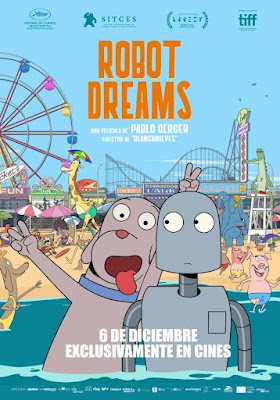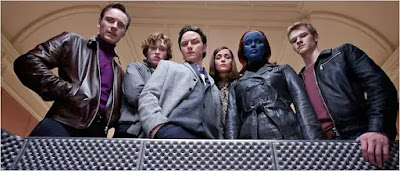X-Men: First Class (2011)
Originally, 20th Century Fox had planned a spinoff feature film centered around X-Men adversary Magneto before that particular standalone project (and others like it) were abandoned. On the other hand, some of the ideas from that film were eventually incorporated into a rebooted/prequel installment in the series. In fact, X-Men: First Class manages to not only balance the differing backstories of Eric Lensherr and Charles Xavier. It does so in a fresh and engrossing setting against the 1962 Cuban Missile Crisis.
To be sure, the movie is bold, exciting, and entertaining. The production design is well-executed (with many clever homages to Sean Connery’s James Bond films from that decade), and the character arcs and action sequences are first-rate. Michael Fassbender’s Magneto and James McAvoy’s Xavier have an incredible, complex dynamic, and headline a superb cast that includes Jennifer Lawrence (Raven/Mystique), Nicholas Hoult (Hank McCoy/Beast), Rose Byrne (CIA agent Moira MacTaggert), and Kevin Bacon (the sinister, energy-absorbing Sebastian Shaw). There’s even some creative, panel-style editing (a first, perhaps, since Ang Lee’s 2003 Hulk), and the blue-and-yellow color scheme throughout is very retro, indeed.
The problem is, the film sends the wrong message about female empowerment and sexuality. Mystique’s “nude” appearance may be more restrained compared to previous X-Men movies, but that didn’t stop the filmmakers from objectifying her blue-skinned form. At least two other characters are immorally objectified: January Jones’ diamond-covered Emma Frost (who walks around in lingerie a lot) and Zoë Kravitz’s dragonfly-winged Angel (a stripper). Some of the violence is disturbing, especially when it involves a coin.
The movie may otherwise highlight worthwhile themes about embracing our own personal flaws or abnormalities. ("You want society to accept you," Erik tells Raven, "but you can’t even accept yourself.") The same goes for genuine horrors or fears related to the Holocaust, Communism, and nuclear war. But this X-Men falls short of being an overall first-class achievement.
The Wolverine (2013)
After the release of X-Men Origins: Wolverine in 2009, Hugh Jackman was reportedly so disappointed with the final product that he wanted to make sure he got the role of Wolverine right the next time a solo movie came about. Fast forward four years later and filmmaker James Mangold directed an adaptation of Frank Miller and Chris Claremont’s limited comic book run from the early-1980s.
The Wolverine acts as a sequel to 2006’s The Last Stand, as the claw-fisted mutant, haunted by the death of Jean Grey, tries to leave his past behind by living as a vagabond, until he’s pulled back in by an elderly Japanese businessman he saved during World War II. In fact, the dying Yashida (Haruhiko Yamanouchi) wants to repay the bruising Logan with mortality, but at a cost. (Ain’t it always the way.)
The story’s Tokyo setting and lone samurai motif is certainly something we’ve never seen in this franchise, let alone a comic book tentpole movie of this level. Jackman is as lean and muscular as he’s ever been with this character. Despite some corny dialogue throughout the film, the actor also manages to give Wolverine a little more depth and thought as a man in pain struggling for a life of peace, something he sees in a romance with an heir of the aforementioned business (Tao Okamoto, in an effective film debut).
The Wolverine also has more intense violence and fierce brawling of any X-Men movie up to that point. Sometimes it’s hard to tell who’s on which side, while its climactic twist leaves little to be desired. It also has a gripping bullet train sequence that defies the laws of physics. Then again, this *is* a movie. One that falls somewhere between an engrossing and harsh character study, and a generic and middling tentpole blockbuster. If anything, it was a step forward from that Origins outing.
Then came the “days of future past” . . .
X-Men: Days of Future Past (2014)
“Is the future truly set?” It’s a question that pervades this engrossing time-travel entry in the X-Men franchise. Set in a futuristic New York City, where unstoppable Sentinel robots have been destroying both humanity and the mutant population, remaining survivors of the latter race (including Charles Xavier, Magneto, and Kitty Pryde) decide to sent the ageless and indestructible Wolverine back to the early-1970s to prevent a political assassination that will ignite the aforementioned war.
Yes, we’ve seen countless time-travel plots in film and TV before (Terminator and Star Trek, anybody?). But director Bryan Singer, screenwriter Simon Kinberg, and company manage to keep things fresh with this race-against-the-clock story that successfully balances action, thrills, drama, comedy, and relevant commentary. But the real draw of X-Men: Days of Future Past is how it acts as both a sequel and a restart, bringing together the cast of the original movies (including Patrick Stewart, Ian McKellan, Halle Berry, and Shawn Ashmore) and those from First Class (James McAvoy, Michael Fassbender, Jennifer Lawrence, and Nicholas Hoult). Plus, its gripping cross-cut action keeps us on the edge of our seats, even if some of the plot details, continuity, and timelines are a little confusing. (The 2015 “Rogue Cut” spends a little more time with these characters, including a subplot with Anna Paquin’s power-absorbing Rogue.)
Other standout characters include the antagonistic Sentinel program director Bolivar Trask (a brilliant Peter Dinklage) and the scene-stealing Quicksilver (Evan Peters). The latter headlines one of the film’s centerpieces: a break-in and escape from the Pentagon (in slow-motion and fast-motion, set to Jim Croce’s “Time In A Bottle”), while another jaw-dropping sequence involves a baseball stadium. Plus, Hoult’s Beast is given a much-better design and look than the last movie.
Similar to X2 from 2003, Days of Future Past features an unlikely team-up, this time where a former-learner (Wolverine) now leads his soon-to-be mentor (Xavier, displaying a different personality, as well as longer hair and a beard). It’s fitting that half of this story is set during the end of the Vietnam War era, as some of these characters have seen friends die, and who have understandable but misguided intentions. Ultimately, the film’s central themes revolve around hopelessness, the power of choices, and second chances (“to define who we are”). As the older Xavier proclaims, “We need you to hope again.”
To be sure, Days of Future Past does have content issues. Its violence and action is intense, and some of its language is rough. Then there’s its sexual content, including one brief moment of Wolverine in the buff, and of course Mystique’s “nude” figure. To be fair, Raven/Mystique is a fully-dimensional character here, and not so much there for eye-candy. She does have a redemptive arc, as does Xavier, but still. And with emotional stakes that are stirring and evocative (including an incredible face-to-face moment for the ages), this is the best crafted, the best acted, and the best X-Men by far. How’s that for set?
Deadpool (2016)
If you were to look up the term, “self-deprecating humor,” one famous name that should be included in that description is Ryan Reynolds. The Canadian actor and natural funnyman has been working in the industry since the early-90s, but hadn’t officially become a household name until the mid-2010s. Since then, he’s become known for making fun of his own career, including one particular superhero role that he’s made no secret of hating. (Hint: green and animated.)
For about a decade, Reynolds had been trying to get a solo feature film outing, based on the ever-popular but profane and violent costumed antihero Deadpool (created in the early-90s by Rob Liefeld and Fabian Nicieza), off the ground, especially after an abysmal interpretation of the character in X-Men Origins: Wolverine. But it wasn’t until a test reel (shot in 2012) was mysteriously leaked on the internet and fan momentum went through the roof that the project got greenlit. (Or should I say, red-lit?)
Furthermore, Deadpool was released during a time when the superhero film genre was starting to get oversaturated. Zack Snyder would present a divisive battle between Batman and Superman. The MCU was entering its third phase of movies. And Bryan Singer would be directing his fourth X-Men movie for Fox. And then there was Reynold’s meta-driven Merc With a Mouth and his Special Ops alter ego Wade Wilson, known for his jabs at all things superhero, as well as random pop culture references.
To be fair, the character can be funny, with his wisecracking fourth wall asides to the audience (“Fourth wall break inside a fourth wall break”), and the movie itself (a parody of a superhero origin story, as well as being its own) has amusing, even hilarious, moments, including fake opening credits. Again, Reynolds is a natural comedian, and witty improviser. Plus, for all its problems, the movie even manages to inject some genuine pathos, in terms of the harsh realities of cancer and the like.
But Deadpool is also, perhaps, the most foul and shameless character in the Marvel universe, taking no prisoners with his banter and violent nature—and making no apologies for it. (The film also spends an entire montage on sex scenes/acts—except for Lent—while another sequence takes place in a strip club with one “gratuitous cameo.” Really?! It should also be noted that Wade's girlfriend is a prostitute.) Make no mistake, this is bloody, graphic, and hard-R material, through and through. And the complete opposite of Uncle Ben Parker’s “With great power” mantra. It’s more than self-deprecating. It’s brutal. At least the guy is right when he says, “I may be super, but I’m no hero.”
For this third installment in the X-Men prequel/reboot series (and director Bryan Singer’s fourth installment overall), the filmmakers went bigger than ever—more than First Class and Days of Future Past put together. Both Singer and screenwriter Simon Kinberg (another key figure in this franchise) have described X-Men: Apocalypse as the origin of the traditional ensemble team, with the titular mutant as the most powerful antagonist they’ve ever faced.
While the main action takes place in the early-1980s, the origins of Apocalypse a.k.a. En Sabah Nur date back 4,000 years to Ancient Egypt, with elements of transference and cultism, as well as themes of false deities, intact. I couldn’t help but think of Stephen Sommer’s special effects-heavy takes on The Mummy amidst all this spectacle, which later becomes world-destroying on the lines of Roland Emmerich or Michael Bay, but with more mythological religious proportions. That said, some of the action and violence is more intense and disturbing (the scene where Angel gets metal wings is wince-inducing, while Wolverine’s forced cameo is as bloody as it’s ever been by far).
Overall, there are things about this entry that work, and others that don’t. I liked the subplot where Erik Lehnsherr a.k.a. Magneto has a wife and daughter—and lives a normal life—in Poland until tragedy strikes. (Michael Fassbender is powerful and emotive.) The younger cast members do an admirable job of emulating the actors that preceded their respective character roles, including Sophie Turner’s Jean Grey, Alexandra Shipp’s Storm, Tye Sheridan’s Cyclops, and Kodi Smit-McPhee’s Nightcrawler. I would’ve liked to see Lana Candor’s Jubilee more (her outfit screams 80s culture). We do get to see James McAvoy’s Charles Xavier with a bald head for the first time and are reminded of the power and strength of teamwork and community.
I do think Oscar Isaac (a terrific actor) was kind of wasted in the role of Apocalypse, despite some impressive makeup and a freaky gaze. This movie also gets back to colorless matching uniforms and conflicting perspectives that feel a little repetitive at times. Apocalypse even tries to outdo that great slow-motion Pentagon escape from Days of Future Past, by having Quicksilver (an awesome Evan Peters) do the same with Xavier’s School as it’s exploding. Set to “Sweet Dreams” by the Eurythmics, this sequence is impressive, though maybe not as memorable as the Pentagon. X-Men: Apocalypse has a lot going on. And I mean a lot!








